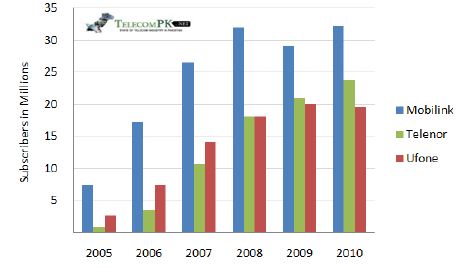Pakistan has now has 100 million mobile phone subscribers.
In a period of a decade Pakistan has gone from a country with minimal telecom infrastructure to a success story when it comes to telecom deregulation, attraction of foreign investment, contribution to economy and growth in subscriber base.
Consumers enjoy far more choices than ever before to select their telecom provider at home, office or for mobile. Prices for domestic and international calls are at their lowest point and broadband Internet cost is approaching the affordable mark. A large number of value added services are available.
Telecom sector has also become one of the major industries in Pakistan, contributing to revenue and leading in foreign investment. Telecom brands have become part of the daily lives of Pakistanis. The sector has been responsible for USF and ICT R&D Fund. Telecom sector has shaped the way corporate social responsibility is perceived in Pakistan. It has also played a vital role when disaster has struck Pakistan.
The sector has been very competitive. The top 3 mobile network operators have 75% of the market: Mobilink, Telenor and Ufone. The chart below gives you a glimpse into the battle for winning over consumers over the last 5 years.
So now that we have reached a major milestone of 100 million subscribers, should we pat our back and go back to business as usual?
Not so fast. I believe that this is just a starting point.
If we want to benefit from this initial growth and make it sustainable then we need to change our approach and step up our efforts to make better use of information and communication technologies. Even though the telecom sector of Pakistan has come a long way, it faces a number of challenges.
- Degradation in quality of network and customer service
- Aggressive price cutting and low ARPUs have made voice and text messaging a commodity
- Saturation of voice and not enough uptake on data services
- Over-emphasis and spending on advertisement
- Rapid shifts in communication modes have impacted our culture in ways which are not always positive
- Imports of phones has caused a strain on foreign reserves
- Digital divide in the country remains an issue
I would argue that the whole sector – private companies, schools and government – has fallen short on supporting research, innovation and creativity which could truly make a difference in the lives of people. In other words, we have reached the first milestone where a significant number of our population can make calls and send text messages. We are missing out on the REAL potential here. And believe me, this is not something that can be easily imported. We need to take this technology and create further value from it.
Engage our youth – the generation which has grown up using mobile phones – and show them productive ways to use communication technologies. My advice would be that The sector should focus on two things: provide economic benefits and to support education for the masses.
When Pakistan reached the 75 million mark in cell phone SIMS back in January 2008, Adil Najam had asked this question, which is still valid :
have we crossed some threshold of excessive cellphone ownership where, despite seemingly low costs, the marginal benefit of ownership no longer exceeds the marginal costs?
My answer is that it depends on what you do with this technology. Playing ring tones is fun but creating best-selling apps or solving problems using your phone is where we want to be. Where we need to be.
Babar Bhatti blogs at Telecom.Net. This post is exclusive to ATP.





















































The trick is not in the phone handset but software. Android anyone?
Pakistan does not favor economies of scale for quite a few industries. You need downstream and upstream infrastructure to manufacture items. Got nothing to do with either the “crumbling” infrastructure nor the lack of foreign investment. No one will manufacture phones in Dubai with all the money in the world. It just does not have the depth of manufacturing capacity.
And everything does not need to be manufactured in Pakistan.
But the items that need to be manufactured and can easily be done, no one is paying attention to them.
What I’m amused about is why Ufone actually lost its subscribers in 2009-2010, when in this year they had made the most noise..
and probably the most entertaining noise..
given that at this time all networks are rather equal in quality and price..
we have talent ,resources as such we can search,manufactire any thing but it needs serious thought ,sincerity and hard work.
Aziz – I am with you on the handset manufacturing comment. I’ve written about it many times. The reality is complex though. With phone manufacturing facilities in India and China and with the crumbling infrastructure in Pakistan, we did not attract a major handset company. Previous governments have tried and failed.
Yet it never occurred to us to invite a couple of phone manufacturers to set up manufacturing units in Pakistan! That could have created jobs for engineers not just sim salesmen.
Seems nobody is interested in thinking AND doing what is right for the country. Some years back we were worried about tea imports now billions of USD are spent on handsets each year…and our engineering graduates are unemployed…sim anyone?